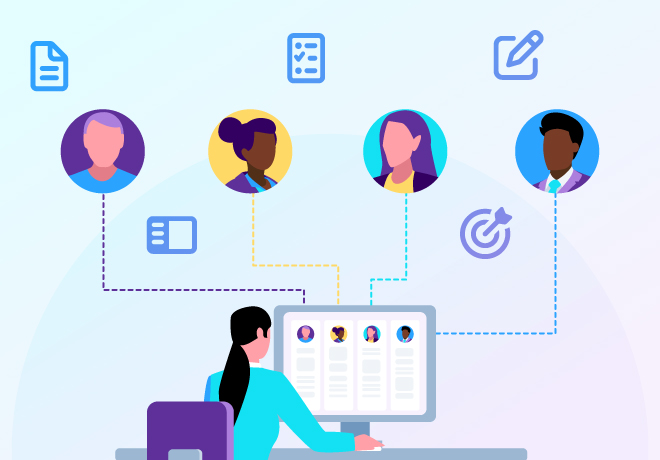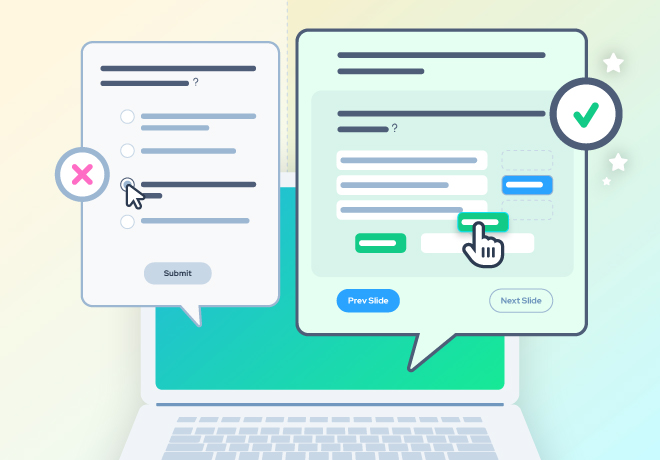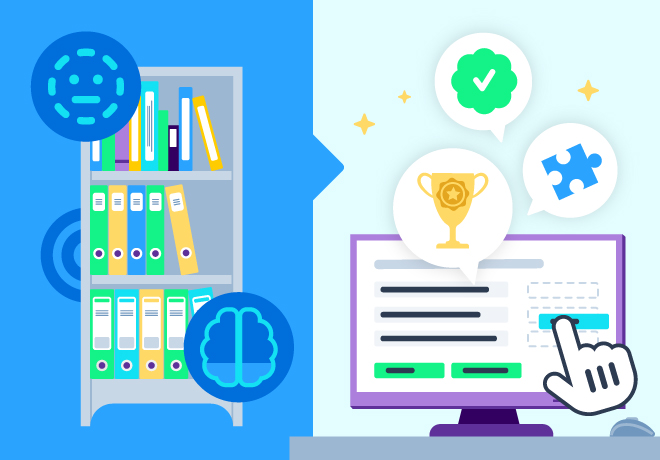
10 eLearning design tips every new instructional designer should know

Related articles
Get valuable eLearning insights to your inbox.
Listen to Neovation’s Demystifying eLearning podcast generated with NotebookLM!
Listen to our podcast on your favorite platform!
As your organization’s expert on essential material, you’ve been asked to design training for a group of employees at your company. But you’ve never designed training before! If you aren’t familiar with custom instructional design and you’re not sure where to begin — no worries! Our top 10 eLearning design tips will set your online training module up for success.
1. Tie training to key business goals
Why are you creating training? If your answer is something like, “Learners have to complete …” or “Learners need to understand …” it’s time to dig deeper. You might discover that training isn’t even the best way to solve the problem!
But if you determine that, indeed, creating training will help, figure out the goal of the training. Effective training focuses on results: What learners will be able to do or how their behavior will change as a result of their training.
Even more important: What you want your learners to know or do should correlate directly to key goals of your organization. The goal might be to reduce the number of safety incidents or improve the ratio of sales to calls made or reduce employee turnover by teaching managers to provide more effective feedback. Perhaps you are trying to improve customer satisfaction scores on call-center surveys.
Identify the business reason that underlies the request for training, then formulate learning goals that will lead to improvement in the behaviors that affect progress toward that goal.
2. Choose an eLearning format that will work
Online training comes in a multitude of formats. You can create a SCORM-based eLearning course or a mass of microlessons. Your eLearning can consist of videos, podcasts, interactive infographics, animations, eBooks, curated content, virtual training sessions … or any combination of these and other formats.
You might choose a blended learning approach, combining one or more online training formats with in-person or virtual instructor-led training.
When choosing a format or blend of formats, consider both the content and the learners’ environment. If you will be delivering training to a fleet of delivery drivers or sales professionals who spend their workday behind the wheel, consider an audio-only format. Mobile-first formats like microlearning and short videos are good choices for gig or contract workers and remote employee training.
The content matters, too, of course. If your goal is improving learners’ interactions with customers or managers’ delivery of feedback to direct reports, multi-branched scenarios or immersive simulation training are outstanding options. Elements of gamification might be the right choice to get employees to review fact-dense content, using spaced repetition to learn new vocabulary or remember which features go with which new products.
3. Start with a storyboard

Once you know the goals and format of your training, your next step is creating a storyboard.
A storyboard helps you visualize your final product. It shows the sections or chapters, as well as the flow of content. Your storyboard should show where interactive activities and knowledge checks appear throughout the training.
Using a storyboard can help you implement another key eLearning design tip: Break complex content into short chunks. This helps you present content in units or lessons that learners can digest easily.
Storyboarding your eLearning can show you whether your initial ideas for eLearning formats are feasible — and save you from making costly errors.
4. Include (only) essential content
The storyboard will help you with structuring your online training content in a way that makes sense to learners. A common mistake is trying to make a single eLearning project cover everything about a topic. But learners can’t absorb an encyclopedia’s worth of information in a single eLearning course!
Decide which content is essential, referring back to your goals: Does the learner need this information to be able to meet your learning goal(s)?
Then, consider your learner population: Are they beginners or experienced? Do they need to become experts or merely be familiar with basic concepts? Will they be performing this process once or once an hour?
You might decide to create training at different levels for novice and experienced learners, add instructional scaffolding to support the newer hires, or create optional resources with the deeper content and detailed explanations.
Include everything that’s essential to your learner audience in your training project — and only what’s essential.
5. Build in accessibility
Your online training should be accessible to all learners. This includes learners with disabilities, learners who are not native speakers of the training language, and learners who are not computer-savvy, as well as learners of all ages, backgrounds, and ability levels.
Truly accessible content is flexible — it offers multiple ways to access content and allows learners to choose a different format or customize content so that it works for them.
In practice, this means including closed captioning and transcripts on all audio content, so that people with hearing impairments or who struggle with the language can read and re-read the content to improve their understanding. Don’t forget alt text for visual images. You can add these elements in the storyboarding stage to ensure that they are included.
Accessibility also means enabling learners to change font size and contrast so they can see and read the content better. If your learner audience is global, it might mean including translations and localizing details like measurement units or examples so they make sense to all learners.
Ensure that all content and interactivities work with keyboard navigation so that learners who use screen readers or adaptive input devices can use the training. For example, a drag-and-drop activity requires a mouse; to ensure accessibility, design an alternative activity that uses keyboard commands.
Building accessibility into your training materials during the eLearning design stage is easier and less costly than having to add it later, so keep accessibility in mind from day one.
6. Include knowledge checks
Your eLearning project might include a pre-test and a final quiz to assess what learners knew at the beginning of training and how far they’ve progressed. Consider sprinkling additional knowledge checks throughout the training.
Knowledge checks can be simple one- or two-question “quizzes” — these are generally not scored or recorded, but serve to allow learners to verify their understanding of the material. Knowledge checks can take other formats, too, like games, matching exercises, fill-in-the-blank, hot-spots, and more.
The point is to break up content with opportunities for learners to apply what they are learning, check their understanding, and reinforce their learning.
7. Always provide feedback
Knowledge checks also provide many opportunities to give learners feedback. Effective feedback consists of far more than a score on a final quiz! It’s a key component of learning.
Feedback given through knowledge checks enables learners to correct misunderstandings before the error becomes deeply embedded in their minds. Feedback on branched scenarios allows learners to try out different approaches to a situation and learn what the potential consequences could be for each approach — before making embarrassing or costly errors on the job.
Feedback also reinforces learning. Whether a learner answers a question correctly or not, and no matter which option they choose in a scenario, the feedback provides valuable information — here’s the preferred choice and why.
8. Give learners choices

Build in choices and flexibility to ensure that content is relevant and keep learners engaged. This might mean:
Offering multimodal eLearning content
Letting learners choose content in formats they prefer or that work better for when and where they are able to do their training leads to greater engagement and improved retention.
Implementing a flexible content structure
Allowing learners to skip content they already know or that’s not useful to them, review critical content multiple times, and choose what to access when encourages greater engagement and ensures that the content they focus on is relevant to them.
Ensuring accessibility in multiple environments
Considering learners’ environment, technology skills and availability, and backgrounds leads to accessible content; keep that going by offering choices that recognize that your learner population likely includes a broad mix of abilities and preferences.
9. Keep it relevant
Requiring learners to consume training content that they view as irrelevant is the quickest way to kill motivation and engagement. Following these eLearning design tips can ensure that training is always relevant:
Consider adaptive delivery
Adaptive training targets each individual learner’s weak areas for extra practice and reinforcement, rather than delivering the same content to all learners.
Use learner personas
A learner persona captures a typical learner in terms of interests, knowledge of the topic, “pain points” that can cause the learner to disengage from training, and preferred approaches to consuming information. To ensure relevance to most or all of your learners, some experts suggest using three to five personas.
Tap into storytelling
Scenario-based training, learning games, and well-written examples are engaging and relevant because they use narrative storytelling. A powerful narrative engages learners and makes content more memorable.
Use realistic examples
When building a narrative, start with a solid foundation. Use examples and scenarios that will resonate with learners because they are realistic or familiar — describing a situation they have faced or are likely to encounter on the job.
10. Boost learner motivation with gamification
There’s a reason that gamified elements and other game-based approaches to eLearning remain popular year after year — gamification boosts learners’ motivation and entices them to engage more often and for longer than many other training approaches.
Gamification requires more than simply awarding points each time a learner answers a question or finishes a unit of eLearning, though. Effective gamification focuses on the results your training seeks — reward learners for closing knowledge gaps or for solving real problems.
Organizations that use gamification and leaderboards — and encourage learners by awarding meaningful prizes — see training engagement and outcomes soar.
Learning Hub: free resources for eLearning
The Neovation Learning Hub contains many free resources and articles that can help you improve eLearning outcomes at your organization. Continue learning about Instructional Design topics, Custom eLearning Development articles, or find new eLearning tools to help you with your eLearning initiatives.

An experienced writer, editor, tech writer, and blogger, Pam helps you make sense of learning science and eLearning technology. She provides information you can use to drive improvements in your training effectiveness and ROI.
Become part of our L&D community
We publish a new learning hub article — full of useful, practical topics — weekly.
Not sure where where you want to start? Jump into one of our recently published articles and see where it takes you!








-svg.svg)
-svg.svg)
-svg.svg)
-svg.svg)